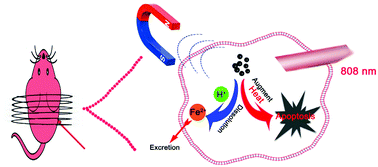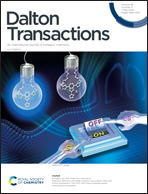High-efficiency and safe sulfur-doped iron oxides for magnetic resonance imaging-guided photothermal/magnetic hyperthermia therapy†
Abstract
Heat therapy is a promising therapeutic modality for cancer treatment due to the minimum adverse effects of selective local hyperthermia; however, the low heating efficiency of heat therapy under safe conditions is an issue for its bioapplication. Here, we report the synthesis of water-dispersible sulfur doped iron oxides (SDIOs) with different phase structures and the exploration of the relationships between the different SDIOs and their induction heating capacities as a guideline to obtain a photo-magnetic hyperthermia agent. The agent exhibits good biocompatibility, excellent photothermal conversion efficiency (55.8%) and great T2 weighted magnetic resonance imaging (63.7 mM−1 s−1). Significantly, the SDIOs effectively eliminate tumours in a biologically safe AC magnetic field range (H·f = 4.3 < 5.0 × 106 kA m−1 s−1) and with 808 nm laser irradiation at a safe density of 0.33 W cm−2; also, they can be mostly metabolized from the body after one month. The work presented here adopts anion-doped iron oxides to dramatically improve photo-magnetic hyperthermia effects and may enable further exploration in thermotherapeutic research.



 Please wait while we load your content...
Please wait while we load your content...